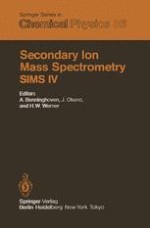1984 | OriginalPaper | Chapter
Secondary Ion Emission Microanalysis Applied to the Uranium Detection in Aquatic Organisms
Author : C. Chassard-Bouchaud
Published in: Secondary Ion Mass Spectrometry SIMS IV
Publisher: Springer Berlin Heidelberg
Included in: Professional Book Archive
Activate our intelligent search to find suitable subject content or patents.
Select sections of text to find matching patents with Artificial Intelligence. powered by
Select sections of text to find additional relevant content using AI-assisted search. powered by
The presence of toxic elements, such as radionuclides, in the aquatic environment and their bioaccumulation within the organisms has increased the need of sensitive and accurate methods to detect them. Uranium was shown to occur in France, in rivers and in the polluted coastal areas of the Channel and the North Sea where various industrial wastes are released (such as U-containing phosphogypsum and TiO2). Uranium is a heavy metal which consists of 3 isotopes: 238 U (99,3%),235 U (0,7%) and 234 U (0,006% , allα emitters, chemotoxic and radiotoxic. Fishes, crustaceans and molluscs were collected from these polluted sites. Sample preparation was made by two methods: 1. fixation in Carnoy liquid, embedding in paraffin, sectioning at 7 μm, deposit on gold specimen holder and removal of paraffin; 2. cryofixation, cryosectioning and deposit on gold specimen holder. Microanalyses were performed with a CAMECA IMS 300 instrument, equipped with an electrostatic deflector. Table 1 indicates the 13 investigated species collected from 12 stations of the Channel and the North Sea.
